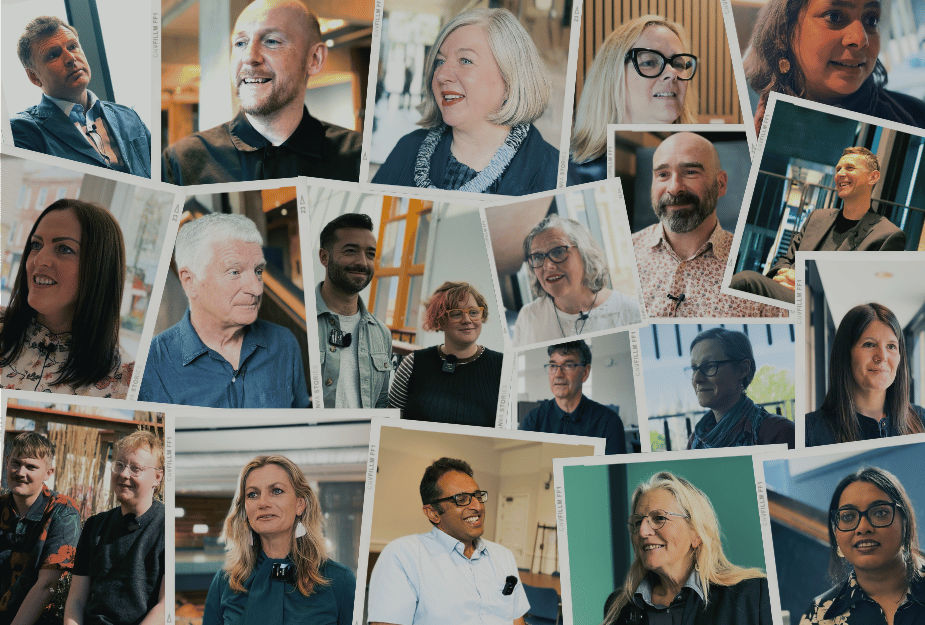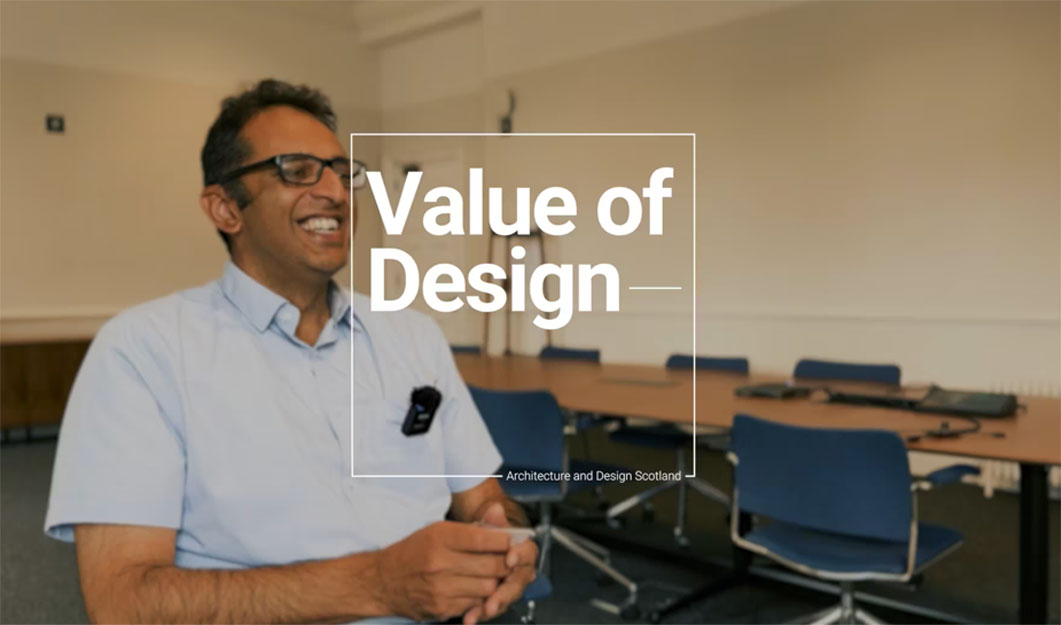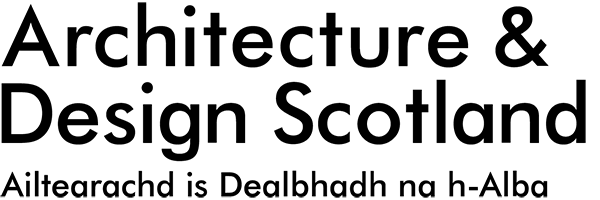Value of Design campaign: how design can improve everyday spaces, buildings and places

What is the Value of Design campaign?
At Architecture and Design Scotland, we believe that design has the power to improve people’s lives. With clear briefs and by involving the right people at the right time, design can create people-friendly, climate-concious places that serve our communities.
The value of design is vast, and good design can be interpreted in many ways. In the 2024 phase of this campaign, we spoke to architects, designers, urban planners, our colleagues and other industry professionals, asking them to share their examples of good design and what the 'value of design' means to them. We have shared the findings below.

Watch our Value of Design videos
Watch Architecture and Design Scotland staff and senior industry professionals talk about the value of design in these short video interviews.
Celebrating the Value of Design: Insights from our interviews
We asked 21 professionals in the architecture and design sector in Scotland to share what the value of design meant to them. They said:
Good design results in happy, vibrant and welcoming places
A recurring theme in the responses was design’s role in making communities more vibrant and accessible. Ann Allen (Chair, Architecture and Design Scotland) highlighted how thoughtful design creates places where people feel “comfortable, welcome, and have a sense of belonging,” using the example of Glasgow University campus redesign opening up travel between the south and west end of Glasgow.
Heather Claridge (Director of Design, Architecture and Design Scotland) highlighted another Glasgow location – the nearby Clay Pits canal project – as an example of how former vacant and derelict land can be transformed into cherished community resources:“…design has been used as a really good way to introduce different walks, routes, play spaces, there's a bridge link so users of the canal can still pass through and get between the health centre and the new housing, and it's also a drainage facility to help support the housing. People use that space and love that space.”
In Dundee, Leonie Bell (Director of V&A Dundee) spoke about the public use of the museum’s outdoor space: “A well-designed place should be a place where people feel happy and it should be intuitive for them to use and easy for them to use…If people don't feel happy in the place or at ease in the place, then it's not designed well enough.”
Good design is considerate and holistic
For many respondents, design is not just about aesthetics or function—good design is careful and considerate. Steve Malone (Principal Architect, Architecture and Design Scotland) described design as “a thoughtful and meaningful way” to bring ideas together and achieve “well-considered outcomes”, using the example of the Bertha Park project outside Perth.
From Open Plan Scotland, Samuel Stair (Chair) and Luca Sode (Student Co-ordinator) highlighted Tonic Housing and London Older Lesbians Cohousing as examples of “considered design” that is “holistically responding to the needs” of users.
While Kev Dhaliwal (Interim Director, Edinburgh Futures Institute) said “Every small detail in the Edinburgh Futures Institute places a context of past, present and future. Our teams have been carefully curating how every experience with the Edinburgh Futures Institute engages people, but also encourages people to collaborate together”.
Good design is collaborative and inclusive
Co-design, collaboration and inclusivity were huge themes within the responses. Lynn Wilson (Board Member, Architecture and Design Scotland) emphasised the importance of involving communities at every stage of the process to ensure design solutions truly reflect the needs and aspirations of the people who use them: “And it's so important when we're thinking about design that we're thinking about how we put the needs of people first – what it is that people actually want and need for their everyday living.”
Danny McKendry (Principal Landscape Architect, Architecture and Design Scotland) described good design as "using lots of different skills of your own, working with people with different skills and professions, and communities coming together to bring together knowledge skills in a really smart and creative way, that allows us to come to better solutions and more effective impacts.”
While Emelie Borg (Senior Corporate Officer, Architecture and Design Scotland) described it as "trying to create the best possible outcomes", saying "the best way of doing that is to involve as many people as possible to give their view of what the design should be and what it should give to people".
Alyesha Choudhury (Co-Founder of /other and Co-Curator of the Scotland + Venice exhibition A Fragile Correspondence) said: "As someone who studied through architecture school, to me, design means that ‘form follows function’, and this means it's an opportunity for innovation and collaboration, and that's what excites me the most about it."
And Rab Bennetts (Bennetts Associates) said: “Ove Arup, the engineer, used to talk about ‘total design’, which was all about engineering and the integration of all the skills you need for design. That's always fascinated me, because it means it's absolutely not a solitary pursuit. It's a collaboration between lots of people, and that's what's interesting about it.”
Good design is key for environmental impact
Design as a tool for environmental stewardship was a dominant theme throughout the interviews. Talking about our Carbon Concious Towns project, Kirsty Macari (Board member, Architecture and Design Scotland) said: "Design is important to create people friendly, climate conscious places, because people need places that are vibrant, that are active."
Alex Laurenson (Urban Designer, Architecture and Design Scotland) highlighted the Climate Action Towns project in Benarty as a good example of engaging with the community, asking what their aspirations and issues are, in order to develop climate solutions that are relevant to the area.
Kimberly Guthrie (Chief Officer, Scotland's Towns Partnership) said: "A climate-conscience and a people-centric vision is critical to a design footprint. There's not a one size fits all to any of this, particularly when you're dealing with place. However, a good, effective design framework really helps regeneration and transformation of our local places."
Ian Gilzean (Head of Digital and Place, Architecture and Design Scotland) spoke about design's ability to reduce the environmental impact of buildings: "Whether it's low carbon [or] low energy housing, there's lots of ways design can help us improve environmental performance, and a lot of the environmental impact of buildings as can be achieved, positive impact can be achieved at the early design stages."
And Becca Thomas (Creative Director and Architect, New Practice) used the Kinning Park Complex as an example of great design within a retrofit project: "The greenest building you have is the one that is already here. And making the most of the heritage and the spaces that we already have, whether they're listed or whether they're unlisted, whether they're particularly valuable or beautiful, it's still the right choice."
Good design is creative problem-solving
Finally, and overwhelmingly, good design was described as a process that brings together creativity and problem-solving. Karen Anderson (President, RIAS) said: "My special interest is in designers as creative problem-solvers, because at the end of the day that’s really what it’s all about." listing Page Parks Housing for New Gorbals Housing Association in Glasgow and Holmes Miller's design for HMP & YOI Stirling as two examples that "demonstrate value of design very profoundly".
Marc Cairns (Managing Director, New Practice) said: "I think design can contribute to places best when it's used both as a problem-solving tool, but also a vehicle for imagination. That's when it really has the power to help people rethink the everyday experiences of the places around them."
Daisy Narayanan (Board member, Architecture and Design Scotland) said "we face twin challenges of coming through the pandemic and life that has changed beyond all recognition, from COVID and, of course, climate change...So to me, the power of excellence in design is to be able to convene different skills, diverse opinions, diverse ideas and come together to face these existential questions of our time."
Finally, Jim MacDonald (Chief Executive, Architecture and Design Scotland) said: "The real value of design for me, is its role in improving people’s lives. It’s not a magic wand, work working with people and understanding the issues, design is the magic which can bring creative innovative solutions to even the most intractable seeming problems."

Value of Design podcast
Alongside the campaign, we launched the pilot episode of a podcast of the same name. The podcast is dedicated to exploring the art and science of creating better places, featuring insightful conversations with leading figures from the worlds of design, architecture and the public sector. In our pilot episode, our Director of Design Heather Claridge and Director of Landscape Architecture at Land Use Consultancy (LUC) Duncan McLean explore the Hamiltonhill Claypits Local Nature Reserve in Glasgow.
Sharing the campaign
We have now wrapped up the 2024 phase of the Value of Design, but our video showcase and podcast episode remains available to watch, listen to, share and engage with. We would love you to share videos that interest you with your colleagues and professional networks, and we hope that they can be useful and inspiring resources for universities and students.
If you would like to talk to us about a specific video or aspect of the campaign, please contact us at info@ads.org.uk with the title 'Value of Design campaign'.
